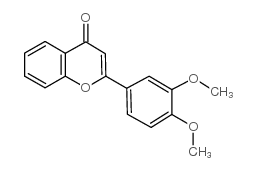Home
Products
3',4'-Dimethoxyflavone



| Product Name | 3',4'-Dimethoxyflavone |
| Price: | $204 / 10mg |
| Catalog No.: | CN04342 |
| CAS No.: | 4143-62-8 |
| Molecular Formula: | C17H14O4 |
| Molecular Weight: | 282.3 g/mol |
| Purity: | >=98% |
| Type of Compound: | Flavonoids |
| Physical Desc.: | Powder |
| Source: | The seeds of Cassia occidentalis |
| Solvent: | Chloroform, Dichloromethane, Ethyl Acetate, DMSO, Acetone, etc. |
| SMILES: | COc1cc(ccc1OC)c1cc(=O)c2c(o1)cccc2 |
| Contact us | |
|---|---|
| First Name: | |
| Last Name: | |
| E-mail: | |
| Question: | |
| Description | 3',4'-Dimethoxyflavone is a lipophilic flavone, can be isolated from the leaves of Primula veris. 3',4'-Dimethoxyflavone can reduce the synthesis and accumulation of PARP and protect cortical neurones against cell death induced by Parthanatos. 3',4'-Dimethoxyflavone is also an aryl hydrocarbon receptor antagonist in human breast cancer cells. 3',4'-Dimethoxyflavone can promote the proliferation of human hematopoietic stem cells. 3',4'-Dimethoxyflavone has various biological activities, including antioxidant, anti-cancer, anti-inflammatory, anti-atherogenic, hypolipidaemic, and neuroprotective or neurotrophic effects[1][2][3][4]. |
| Target | PARP, Aryl hydrocarbon receptor[1] |
| In Vitro | 3',4'-Dimethoxyflavone (10 and 20 μM) has protection against the reduction in SH-SY5Y viability induced by Methylnitronitrosoguanidine (MNNG) (HY-128612)[2]. 3',4'-Dimethoxyflavone (6.25-25 μM) decreases the levels of PAR induced by MNNG in HeLa cells[2]. 3',4'-Dimethoxyflavone (12.5, 25, 50 and 100 μM; 15-20 h) reduces cortical neuronal death induced by exposure to NMDA (HY-17551)[2]. 3',4'-Dimethoxyflavone (0.1-10 μM; 24 h) exhibits significant inhibition of 2,3,7,8-Tetrachlorodibenzo-p-dioxin (TCDD)-induced EROD activity in MCF-7 and T47D cells[3]. 3',4'-Dimethoxyflavone inhibits AhR-dependent CYP1A1 induction and AhR-mediated inhibition of estrogen-induced gene expression in T47D and MCF-7 breast cancer cells[3]. 3′,4′-Dimethoxyflavone (2.5 μM; 7 days) promotes the proliferation of human hematopoietic stem cells[4]. Cell Viability Assay[2] Cell Line: Primary cortical neurones (isolated from fetal CD1 mice, incubated with NMDA) Concentration: 12.5, 25, 50 and 100 μM Incubation Time: 15-20 h Result: Reduced concentration-dependently neuronal death induced by exposure to NMDA. Cell Proliferation Assay[4] Cell Line: CD34+ cells Concentration: 2.5 μM Incubation Time: 7 days Result: Induced a significantly higher amplification of the CD34+ population under normoxia. |
| Density | 1.242g/cm3 |
| Boiling Point | 428.5ºC at 760 mmHg |
| Flash Point | 190.6ºC |
| Exact Mass | 282.08900 |
| PSA | 48.67000 |
| LogP | 3.47720 |
| Storage condition | room temp |